The Death of AI PoCs: A New Model for Buying AI in the Enterprise
The Death of AI PoCs: A New Model for Buying AI in the Enterprise
TL;DR:
- Proofs of Concept (PoCs) only made sense for old school software & SaaS products.
- Running a PoC for AI is like hiring a human for a one-week trial of made-up tasks - you learn nothing about real performance.
- Testing AI solutions and Digital Workers should mirror the hiring process - give the Digital Workers a probation period and observe how they actually get the job done.
- PoCs slow value creation, trapping enterprises in analysis mode instead of outcome mode.
- Digital Workers replace PoCs with production-ready deployment - live in days, measurable ROI from day one.
Intro
The request for a proof of concept (PoC) used to be a standard part of enterprise software procurement. It was a logical, low-risk way to test a vendor’s claims. But for artificial intelligence, the PoC model is broken. It’s a relic from a time when AI was a novelty, a distant and hoped for prospect. Today, as AI becomes a core driver of rapid business transformation, the PoC is an obstacle to progress. With our deployment cycles often measured in hours, organizations can implement Digital Workers in days and start realizing value immediately.
This marks a fundamental shift in how companies evaluate, buy, and deploy AI. The goal is no longer to see if a piece of technology can work in isolation. The goal is to prove it does work in your live operational environment, delivering measurable business value. Just as you wouldn’t test a future hire on the grounds of whether they can complete a task irrelevant to the business context, you shouldn’t evaluate AI in isolation from the environment where it’s meant to create value. Naturally, you would want to see real outcomes. This article will explain why PoCs are failing and provide a practical framework for running a successful AI probation period.
Why the Traditional AI PoC is Obsolete
The old model of running a PoC in a sandbox environment is fundamentally misaligned with how AI delivers value. Business leaders are growing impatient with lengthy evaluations that produce little more than a slide deck. The entire approach is flawed for several key reasons.
AI "Magic" Is in the Last Mile, Not the Demo
Anyone can assemble a slick AI demo. The underlying large language models and technical capabilities have become widely accessible. A PoC that only showcases a model’s ability to perform a task in a controlled setting tells you nothing about its real-world value.
The true "magic" of AI happens in the final mile: the deep integration into your existing workflows, systems, and data streams. It’s about productizing a solution that your team can actually use to get their work done faster and better. A PoC rarely, if ever, tests this. It focuses on conceptual capability, not operational impact.
Budgets Have Shifted from Innovation to Transformation
For years, AI projects were championed by innovation teams, often struggling to get business buy-in. Their primary tool was the PoC, used to prove the technology’s potential usefulness. That dynamic has completely changed.
Today, the C-suite isn't questioning whether they need AI; they're demanding to know how quickly it can be deployed to drive efficiency and competitive advantage. AI budgets are no longer experimental "innovation" funds. They are "transformation" budgets, with high expectations for ROI. This new reality demands an evaluation method focused on immediate, tangible outcomes, not theoretical potential.
Mindset Shift: From Buying Software to Hiring Digital Workers
The most successful leaders are reframing their approach to AI. They aren't just buying software (a capital expenditure); they are hiring digital workers to augment their human teams (an operational expenditure). You don't ask a promising job candidate to complete a six-month, unpaid project in a simulated office. You hire them and give them a probation period to prove their value on the job.
The same logic applies to Digital Workers. The evaluation should focus on performance within your live environment. Does this "AI teammate" collaborate effectively? Does it follow your business rules? Does it improve the team's overall output? A PoC can't answer these questions, but a production probation period can.
The Catastrophic Failure Rate of AI PoCs
The data confirms what many leaders have experienced firsthand: most AI PoCs fail. An often-cited MIT study highlights that a staggering percentage of these projects, sometimes estimated as high as 95%, never make it into production. The primary culprit isn't the technology itself. It’s the friction caused by introducing new processes and platforms.
PoCs often require employees to learn a new interface or work outside of their established systems. This creates resistance and a steep learning curve, dooming the project from the start. Modern AI, particularly with the advanced reasoning models that our Digital Workers have, should do the opposite. It should automate existing end-to-end processes with minimal disruption. You should not be asking whether your team can adapt to a new AI pilot, but whether the AI can adapt to your business.
Furthermore, leaders are facing immense pressure to deliver results. The traditional PoC process is painfully slow. It involves lengthy evaluations, often with multiple vendors, complex setup, and significant time investment from your best technical talent. Companies are implementing AI now, they’re not engaging in a multi-quarter PoC bake-off.
This is why, despite the high failure rate of AI pilots, 78% of organizations now use AI in at least one business function - up from only 55% the previous year - demonstrating a dramatic acceleration past the PoC stage.
The Solution: A Production Probation Period
Instead of a PoC, propose a time-boxed, in-production probation period. This is a real deployment with real data, governed by your security and compliance standards, and includes a clear rollback plan. It's a low-risk, high-reward approach that answers the one question that matters: does this AI solution deliver value in my specific business context?
Here is a pragmatic guide to structuring a successful AI probation period.
Define Clear Success Metrics
Before you begin, define what success looks like. These should be business outcomes, not technical checkboxes.
- Efficiency Gains: Reduction in time spent on a specific process (e.g., territory planning cycles accelerated from weeks to hours).
- Cost Savings: Measurable reduction in operational costs or resource allocation.
- Quality Improvement: Reduction in error rates or increase in compliance.
At causaLens, we always aim to achieve 5x ROI with our Digital Workers, that means for every $1 you spend, you get $5 back.
Prioritize Security and Compliance
Treat this as a full production deployment from a security perspective.
- Ensure the vendor meets all your data handling, privacy, and security requirements (e.g., SOC 2, ISO 27001, GDPR, CCPA).
- Conduct a security review of the integration points and data flows.
- Confirm data residency and processing protocols align with your corporate policies.
Our Digital Workers are always integrated with the safety requirements that even the most stringent GxP industries require. Our real-time reliability tracking ensures no workflow runs unseen.
Use an Integration Checklist
Focus on seamless integration, not a new platform to add to your SaaS sprawl.
- Does the AI work effectively within, or above, your primary systems (e.g., Salesforce, Workday, HubSpot)?
- How are tasks assigned to the Digital Worker and how are results delivered back into the workflow?
- How easily can the Digital Worker be tweaked as your workflows, data, or business rules change?
What Vendor Accountability Looks Like
The vendor should be a partner in this process, not just a supplier.
- Schedule weekly check-ins to review progress against the defined metrics.
- Establish clear support channels and SLAs for any issues that arise.
- Ensure the vendor’s success is tied to your outcomes.
Stop Experimenting, Start Executing
The era of AI tourism is over. Your competitors are not running PoCs; they are deploying AI into production to gain an edge. Continuing with slow, inconclusive proofs prevents businesses from ever leaving the pilot stage - leaving millions of dollars in unrealized value on the table.
Too many AI initiatives stall in “proof of concept” mode - glittering demos that never translate into production value. Instead of agreeing to another PoC, ask for a production probation period. The right partner should be able to deploy securely into your live environment and show measurable results within 30 days. Anything less suggests their technology isn’t ready for the realities of your operations. Transformation doesn’t happen in test environments - it happens when solutions prove reliable under real-world conditions.
Replace your PoC pipeline with a production probation program. Start measuring AI on its performance, not its potential.
An AI PoC tests capabilities in a controlled, sandboxed environment, often disconnected from real workflows. A production pilot (or probation period) runs in your live environment with real data, security controls, and measurable business outcomes, proving operational value quickly.
Ensure there are clear guardrails for production - pilots won’t demonstrate this. Require SOC 2 or ISO 27001, strong encryption, judge agents that validate outputs, comprehensive audit logs, clear data residency, and DPA/BAA where applicable.
They use standard connectors/MCPs to operate within or above core systems (e.g., CRM, ERP, HRIS). Define task assignment, input/output data flows, exception handling, and change management. Prioritize minimal UI changes and ensure the Digital Worker can be tuned as processes, data, or rules evolve.
Most AI pilots stall because they’re run in sandboxes, not in live workflows where value is created. Teams evaluate model “capability” instead of operational impact, introduce new interfaces that disrupt habits, and underestimate integration, data quality, and change management. Pilots also lack clear success metrics, executive ownership, and vendor accountability. Shift to a time-boxed, in-production probation with defined KPIs, tight integration to core systems, security/compliance parity with production, and weekly reviews tied to business outcomes.





